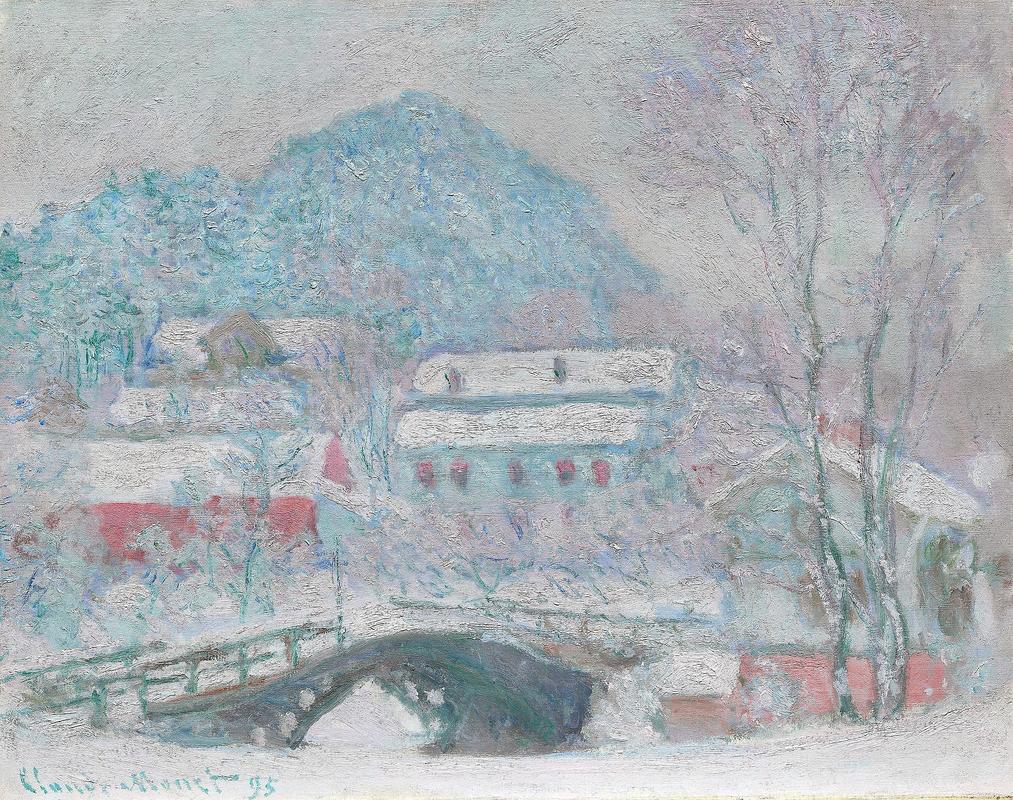More about Sandvika, Norway

Contributor
In 1895, Claude Monet went to snowy Norway and returned with twenty-nine paintings. Sandvika, Norway is one of those paintings.
It’s hard to believe the Frenchman would leave behind his beautiful Giverny home even for a handful of months, but the Norway trip was prompted by a desire to see his stepson, Jacques. After marrying a Norwegian gal, Jacques relocated to Christiania (present-day Oslo) and it left Monet’s wife Alice a little concerned. Alice wanted to know if her son was going to return to Giverny or remain abroad and continue his trade as a shipbuilder, so she sent Monet to find out.
The trip was a roller-coaster of emotions Monet could have penned a Lonely Planet series about. It took three days to reach Norway from Giverny, France and the journey had Monet feeling his age, about which he remarked, “It’s a difficult voyage when you are no longer twenty years old," which is very #relatable. Once there, he was feeling some mixed emotions. On the one hand, Norwegian culture immensely appealed to him, unlike the snow, which prevented him from finding any interesting motifs to paint. But after two weeks and finding nothing to paint, he considered heading back to his beautiful and uneventful lilies in France.
Of course, Monet didn’t leave, otherwise, we wouldn’t have this work. Maybe he found his sense of humor. In a letter to Gustave Geoffroy, he wrote about his time painting under the falling snow, completely covered in white, his beard becoming icy. He also involved himself in the winter activities of hiking, sleigh rides, and possibly, if I can make a farfetched guess, snowball fights. Because who could resist? In a letter, he remarked that the small town outside of Christiania reminded him of a “little Japanese village,” which may be why he was so enamored with it; Monet had a Japanese style bridge like Sandvika's in his garden at home.
By February, Monet had started an eight canvases filled with his impressions of the Norwegian landscape. He also gained inspiration from the Norwegian artist Frits Thaulow, who was known as ‘the Painter of Snow’ thanks to the way he depicted the icy weather in his Impressionist-style paintings, often using pastels to depict white, blowing blizzards.
Although Monet held on to many of his Norway paintings, he donated Sandvika, Norway to a public auction honoring Alfred Sisley, who died in January of that year. The auction commenced in May 1899 to provide some income for Sisley’s living children. Monet’s stardom could attract a decent amount of attendees. For 6,300 francs, French art dealer Paul Durand-Ruel bought Sandvika, Norway, adding it to his collection of Norwegian paintings by Monet. The painting ended up in the hands of Chicago philanthropist Harriet Blair Borland. When Borland died in 1933, her son Bruce donated it to the Art Institute of Chicago.
Monet went on to produce over a hundred snowy landscape paintings by the end of his career, painting six in Sandvika alone. Quite an impressive effort for the man who claimed that snow left him nothing to paint.
Sources
- Abrahams, Simon, “Monet’s Au Bord du Fjord, pres Christiania (1895), Every Painter Paints Himself, January 24, 2014. Accessed January 8, 2020. https://www.everypainterpaintshimself.com/article/monets_au_bord_du_fjo…
- Bashir, Basharat, “Featured Artist: Edvard Munch,” The Kashmir Images, July 26, 2020. Accessed January 8, 2020. https://thekashmirimages.com/2020/07/26/featured-artist-edvard-munch/
- Brodskaya, Nathalia. Claude Monet. London, UK: Parkstone International, 2011.
- Brodskaya, Nathalia, Nina Kalitina. Claude Monet: Volume 2. New York, USA: Parkstone International, 2015.
- Groom, Gloria. Monet and Chicago. Chicago, IL: The Art Institute of Chicago, 2020.
- Nayeri, Farah, “A glimpse inside Claude Monet’s private art world,” New York Times, September 8, 2017. Accessed January 6, 2020. https://www.nytimes.com/2017/09/08/arts/design/claude-monets-private-co…
- Penn, Alexander, “Did you know Monet painted more than 100 snow scenes?” Denver Art Museum, December 4, 2018. Accessed January 8, 2020. https://www.denverartmuseum.org/en/blog/did-you-know-monet-painted-more…
- Prideaux, Sue. Edvard Munch: Behind the Scream. New Have, CT: Yale University Press, 2005.
- Tucker, Paul Hayes. Monet in the ‘90s. Boston, MA: Museum of Fine Arts, 1989.











